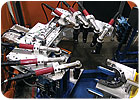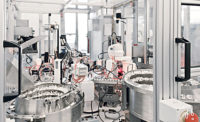Advanced Machine & Tool has developed unique automated processes specifically for diesel particulate filters and diesel oxidation converters.


Two such technologies are diesel particulate filters (DPFs) and diesel oxidation converters (DOCs). Assembling these components is challenging, because they are relatively large and contain fragile components.
Advanced Machine & Tool (AMT) has developed unique automated processes specifically for these components. So when an emissions control company approached AMT to develop an automated assembly system for a DPF, AMT knew how to make it happen.
AMT developed a flexible assembly cell that can meet the needs of today as well as the needs of the future. In this profile, AMT automation manager Erik Linnemeier describes how the machine works. For more information, call 260-489-3572 or visitwww.amt-corp.com.
Describe the system. The machine is a six-position rotary table. The parts sit vertically in the nests. At the first station, an operator loads a DPF with a lift-assist device. The operator manually places a gasket on the DPF. The gasket fits over some studs and onto a flange. Next, the operator loads the DOC flange onto the studs with the lift-assist. Once in position, the DOC assembly is automatically clamped in place. A poka-yoke device ensures the DOC and DPF are correctly oriented.
At the second station, an operator manually places and starts a pressure tube and nuts on all seven studs.
The third station is a spare that can be used for contingencies or future processes.
The fourth station consists of eight right-angle GSE nutrunners mounted on pneumatic slides. Seven nutrunners tighten the nuts to 40 newton-meters. The eighth tightens the pressure tube to 15 newton-meters. Each tool is independently controlled by the PLC, and torque and angle data are collected from each fastening operation.
At the fifth station, the assembly is tested for leaks. The part is clamped and sealed in all areas with urethane pads. The ends of the tube, pressure ports and temperature ports are closed off, and the part is tested for a leak rate of 9 standard liters per minute at a pressure of 15 psig. A Cosmo AF2201 performs the test. If the assembly passes, a Telesis TMP 1700 etches a 2D bar code onto the part.
The finished assembly is unloaded at the sixth station. Prior to unloading, the information linked with the bar code is read and recorded with a Microscan reader. The clamps release automatically, so an operator can remove the assembly.
What are the dimensions of the finished assembly?The assembly is roughly 6 feet tall and 10 inches in diameter. The machine can accommodate much smaller or larger parts both in length and diameter.
What are the parts made of?Rolled steel and heat-resistant fiber matting.
What is the production rate?Takt time for the largest assembly is 48 seconds, part to part, including indexing and the time to fill, stabilize and exhaust the leak-testing gas.
Can the system accommodate variants?The system provides ample room at each station. This enables the machine to accommodate tubes with varying bend profiles and lengths. The user-friendly HMI allows operators to select various assembly recipes from a menu. Graphical isometric displays help operators quickly select and collect critical assembly data.
What was the most challenging aspect of designing and building the system?The most challenging aspect was ensuring that the finished assembly was 100 percent sealed in all areas for the leak test. We found off-the-shelf urethane seals, but integrating them into a standard “one station fits all” design brought about some challenging discussion that ultimately yielded a robust solution.
What else would you like ASSEMBLY’s readers to know about the system?This system is based on a rotary-indexing dial. However, we also designed a rail-guided system that has all the same features, but opens up opportunities for additional stations and full automation. The rail system is more rectangular and can be varied in size. In the fully automated version, the parts would be loaded and unloaded with a six-axis robot. The pressure tube and nuts would be fed from vibratory bowls and placed by the robot. This system is also integrated with a plant-level supervisory PC.
Editor’s note: Whether you’re a systems integrator or the in-house automation team of an OEM, if you’ve designed a system that you’re particularly proud of, tell us about it. Send an e-mail to John Sprovieri, editor of ASSEMBLY, at sprovierij@bnpmedia.com, or call 630-694-4012.




